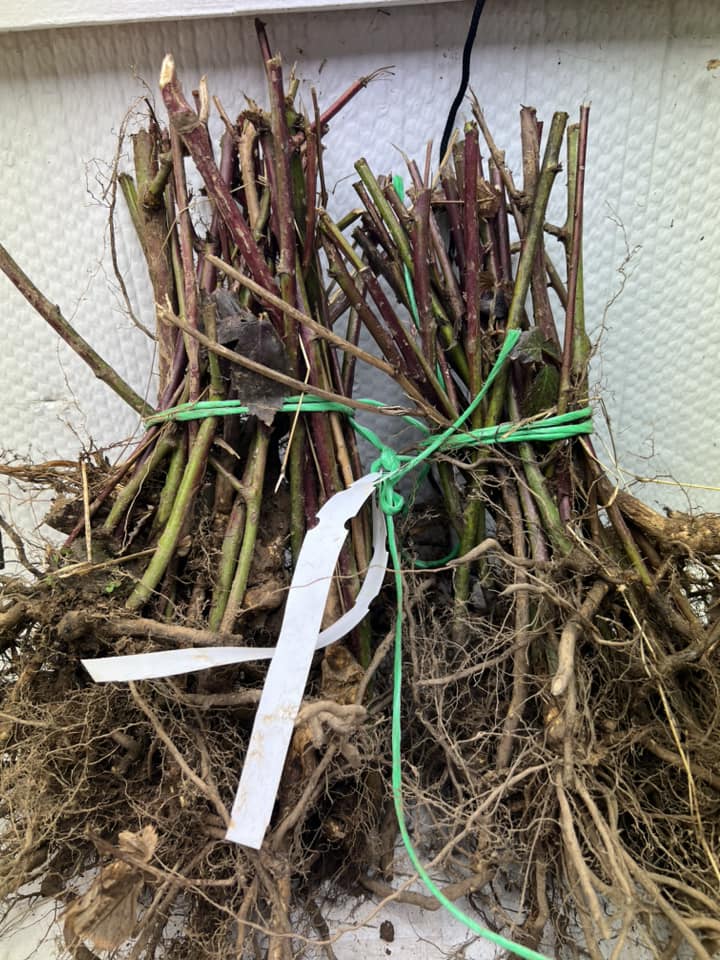Description
Osage Blackberry
—-
‘Osage’ is a relatively new blackberry (Rubus species) cultivar developed by the University of Arkansas, well-known for its excellent flavor, sweetness, and thornless canes. Like other Arkansas-released blackberry varieties (e.g., ‘Ouachita,’ ‘Natchez,’ ‘Prime-Ark® Freedom’), ‘Osage’ was bred for improved flavor, productivity, disease resistance, and ease of harvest in both commercial and home garden settings.
Below is an overview of key characteristics:
1. Origin and Breeding
- Breeder: Developed by Dr. John R. Clark and the fruit breeding program at the University of Arkansas.
- Goals of the Breeding Program: Thornlessness, consistent yield, improved fruit flavor, and adaptation to a wide range of growing regions.
2. Plant Characteristics
- Growth Habit: Erect, self-supporting canes that do not typically require extensive trellising.
- Thornless: Canes are smooth, making harvest easier and more pleasant than with thorned varieties.
- Cold Hardiness: Performs well in many temperate regions, commonly suggested for USDA Hardiness Zones 5–9. Protecting plants from extreme cold in the northernmost zones or from very hot, dry conditions in the south will ensure better performance.
3. Fruit Qualities
- Size and Appearance: Medium to large, glossy black berries with a uniform shape.
- Flavor: Known for a balance of sweetness and acidity. Many gardeners and taste panels rate ‘Osage’ very highly for flavor.
- Seeds: Small seeds that do not dominate the eating experience, adding to its overall appeal.
- Ripening Season: Typically an early to mid-season berry, often overlapping with varieties like ‘Ouachita.’ The exact timing depends on local climate.
4. Yields and Harvest
- Productivity: ‘Osage’ has consistent and reliable yields, especially if maintained with proper pruning and fertilization.
- Harvest Window: The main harvest period lasts several weeks; in many climates, this starts in early summer (e.g., June or July in much of the United States).
- Ease of Harvest: Thornless canes make picking much more comfortable; the erect growth habit helps keep fruit off the ground, reducing rot and improving fruit quality.
5. Growing and Care Tips
- Site Selection
- Choose a sunny location (at least 6–8 hours of direct sunlight per day).
- Ensure good drainage to prevent root rot—raised beds or mounded rows can help in wetter climates.
- Soil Preparation
- Blackberries prefer slightly acidic to neutral pH (around 5.5 to 7.0).
- Incorporate organic matter (compost, well-rotted manure) before planting to improve soil fertility and structure.
- Planting
- Space plants about 3–4 feet apart in rows, with 6–8 feet between rows.
- Planting in early spring is most common in colder regions; fall or winter planting can work in milder climates.
- Watering and Fertilizing
- Provide consistent watering, especially during fruit set and ripening.
- An all-purpose berry or fruit fertilizer applied in early spring and again in late spring or early summer can support growth and yields.
- Pruning and Training
- Remove spent floricanes (second-year fruiting canes) after harvest.
- Tip or top new primocanes (first-year growth) in late spring to encourage lateral branching, leading to more fruiting sites the following year.
- Pest and Disease Management
- Thornless blackberry varieties like ‘Osage’ are generally low maintenance, but watch for common issues like anthracnose, cane borers, or fruit rot.
- Provide good air circulation (adequate plant spacing) to reduce disease pressure.
6. Recommended Uses
- Fresh Eating: Thanks to its excellent flavor, ‘Osage’ is outstanding for enjoying straight off the plant.
- Preserves and Baking: Use in jams, jellies, pies, and cobblers—small seeds and good flavor translate to high-quality products.
- Landscaping: Thornless canes and attractive, shiny fruit can make it a functional (and edible) ornamental in a home garden setting.
In Summary
The ‘Osage’ blackberry combines high-quality flavor, consistent production, and thornless canes—making it a favorite among both commercial growers and home gardeners. Its upright habit and small seeds enhance its appeal, while the University of Arkansas breeding lineage ensures hardiness and adaptation to a broad climate range. If you want a blackberry plant that is easy to pick and yields delicious berries in early to mid-summer, ‘Osage’ is definitely worth considering.







